Allwinner & HonHai Precision Industry, better known as Foxconn, sent me an Infocus tablet based on Allwinner A83T processor with eight Cortex A7 cores up to 2GHz, and a PowerVR SGX544 GPU. Today, I’ll list the specifications of this tablet, show unboxing pictures, first boot video, and run Antutu benchmark.
Infocus New Tab CS1 A83 / C2107 Specifications
The invoice calls the tablet “New Tab CS1 A83”, but Android reports the model as C2107, so I’m not fully sure what will be the actual name. It might well be New Tab CS1 A83, as I could find an Infocus an earlier Infocus New Tab CS1 tablet powered by Allwinner A31.
Anyway, here are the specifications I could derive from the device, and running Antutu/CPU-Z on the device:
- SoC – Allwinner A83T octa-core ARM Cortex-A7 @ 2.0 GHz with PowerVR SGX544MP GPU supporting OpenGL ES 2.0/1.1, OpenCL 1.1, DX 9.3.
- System Memory – 2 GB RAM
- Storage – 16 GB eMMC + micro SD slot
- Display – 7″ capacitive touchscreen, 1920×1200 resolution.
- Audio – 3.5mm headphone jack, stereo speakers
- Connectivity – 802.11 b/g/n Wi-Fi and Bluetooth
- Camera – 8.0 MP rear camera, 1.9 MP front-facing camera
- USB – 1x micro USB OTG?
- Sensors – Orientation, G-sensor, accelerometer, magnetometer, light sensor, gyroscope
- Misc – Power and volume buttons,
- Power Supply – 5V via micro USB port
- Battery –
3250 mAh (TBC, based on older CS1 specifications)3,550 mAh (Liliputing opened the tablet)
- Dimensions – 190 x 108 x 89 mm
- Weight – 290 grams
Infocus CS1 A83 Pictures
I got the tablet from Foxconn Hong Kong via DHL, in the following white Infocus package.
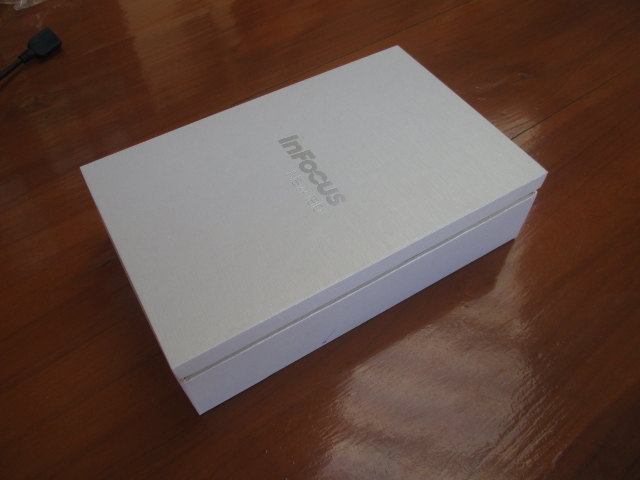 The tablet comes only with a 5V/2A and its USB cable, but it might be because I’ve got an early sample, and once it become available, there may be a user’s manual, screen protector, and many other accessories like a pair of headphones.
The tablet comes only with a 5V/2A and its USB cable, but it might be because I’ve got an early sample, and once it become available, there may be a user’s manual, screen protector, and many other accessories like a pair of headphones.
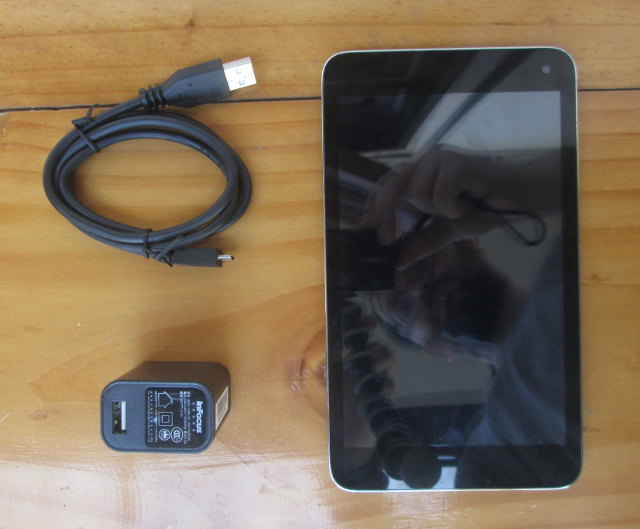
On the front, we’ve got the display and the 2MP front-facing camera. Stereo speakers are located on the bottom of the back of the tablet, and the rear camera on the top.
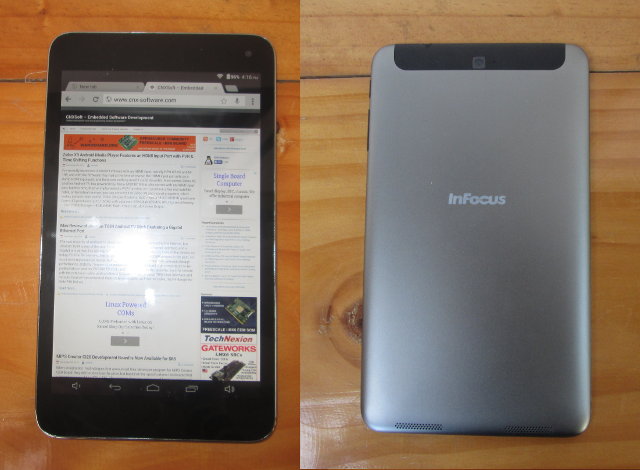
The other ports are power and vol +/- buttons on the side, and micro USB port, headphone jack and micro SD card slot on the top of the device.
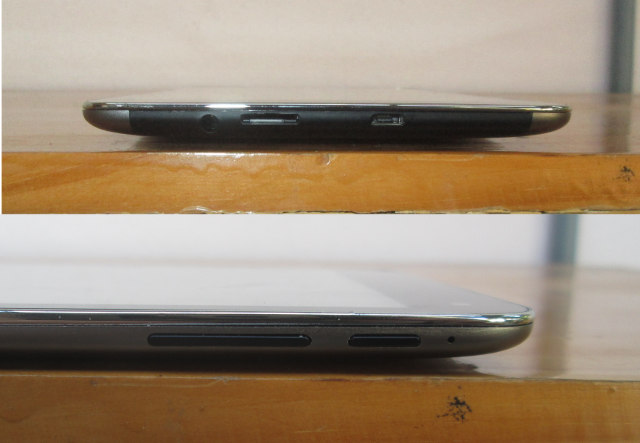 First boot
First boot
The tablet came fully charged, and pressing the power button one or two seconds boots the tablet, and Infocus tablet boots in just 15 seconds, it’s the fastest boot ever for the Android devices I’ve reviewed so far. You can watch the video below to see the unboxing and first boot for this tablet.
At first I thought Google Play was not installed in the tablet because I did not see the Google Play Store app in the list of apps.
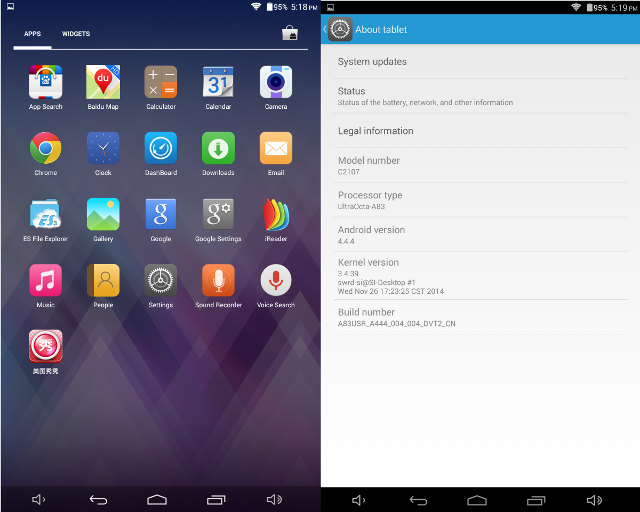
But I eventually found out the Play Store was installed when I accessed it in Chrome, and looking again in the list of apps, the small icon on the top right is for the Play Store. I don’t know if this is standard in all Android 4.4 tablet, or Foxconn customized it. The About Tablet section in Android section shows the model number is C2107, the processor UltraOcta-A83, and Android 4.4.4 runs on top of Linux 3.4.39.
The only problem I found during the first few minutes of usage is with the volume down button. I need to press it quite hard, and it won’t work. I don’t have this problem with the volume up button.
Allwinner A83 / Infocus C2107 Tablet Benchmarks
Alwinner A83T is a very new processor, so I ran CPU-Z to get information about both the processor and the tablet.
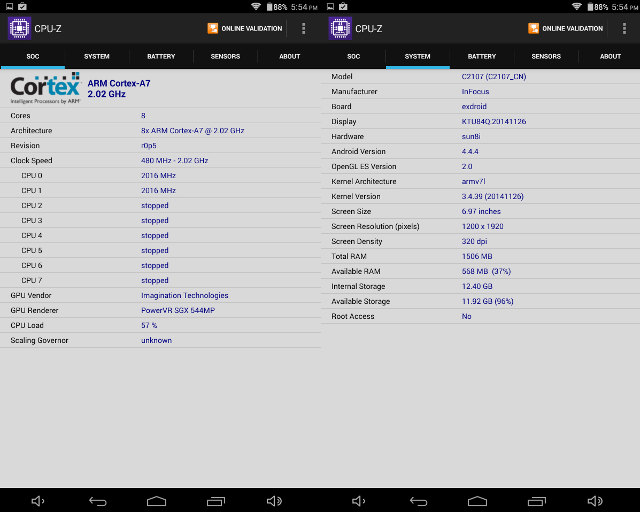
CPU-Z correctly detects the processor as an octa-core Cortex A7 clocked between 480 MHz and 2.02 GHz, and with an Imagination Technologies PowerVR SGX 544MP GPU. The model number is C2107 (C2107_CN) and the manufacturer Infocus. Kernel developers may be interested to learn / know AllwinnerA83T is an sun8i platform. Screen resolution is 1920×1200 pixels, 1506 MB RAM is accessible in Android (the rest being used for the VPU, and other hardware buffers), and the internal storage partition 12.40 GB.
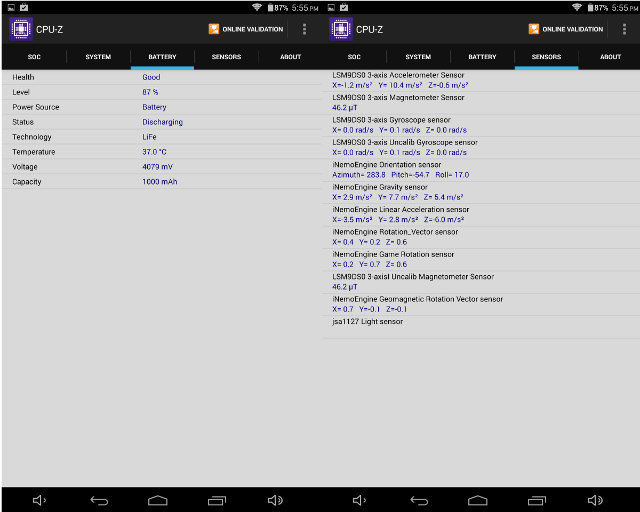
The battery capacity (1,000 Mah) reported by CPU-Z is most probably incorrect. The tablet has a bunch of sensors as reported in the specifications.
Now time for Antutu 5.3 benchmark.
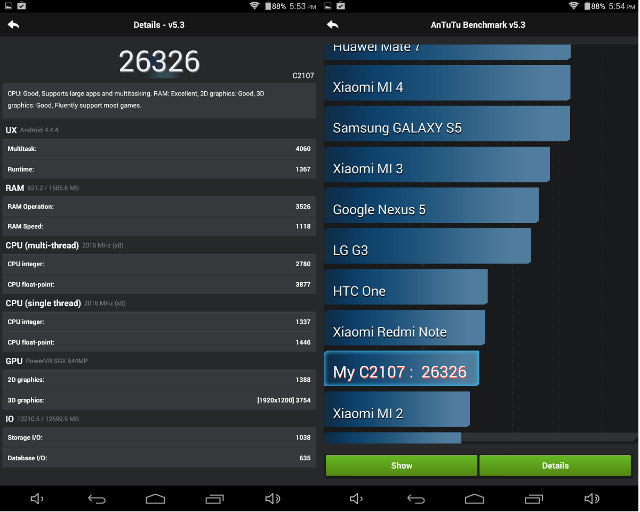
With 26,326 points, Infocus New Tab CS1 A83 is a mid range tablet, with a score between Xiaomi MI 2 (Qualcomm Snapdragon S4 Pro – APQ8064) and Xiami Redmi Note (Mediatek MT6592).
That’s all for today. I plan to use the device for about a week, mainly browsing the web, checking email, watching videos, and playing games. I’ll also make sure to test the rear and front camera, evaluate the battery life (Is there a standard tool), runs some more benchmark, and report any issues I may have had in the full review. let me know if you’d like me to test anything specific.
The tablet is not currently up for sale, but the proforma invoice I received specifies the price is $170 per unit.

Jean-Luc started CNX Software in 2010 as a part-time endeavor, before quitting his job as a software engineering manager, and starting to write daily news, and reviews full time later in 2011.
Support CNX Software! Donate via cryptocurrencies, become a Patron on Patreon, or purchase goods on Amazon or Aliexpress. We also use affiliate links in articles to earn commissions if you make a purchase after clicking on those links.




The charger is an exact copy (or just the same) as Lenovo is selling with its Yoga Tablets 😉
https://play.google.com/store/apps/developer?id=LAB501
Very good standartized battery test. There is three seperate test to measure battery for gaming,video and browsing.
Allwinner … this antutu score is a joke
i’ve got a better score on an amlogic S802H (A9 X4 2.0ghz)
Thanks for the early review. It is an interesting chip, but its high time that Allwinner actually has a commercial success with a new chip. After the Allwinner A33/A31s (early part of 2013), all I see is delays and commercial failures (A20, A23, A33 etc). The A80 is probably also a commercial failure because it hasn’t shipped in a lot of tablets (where the volume is, chip companies don’t earn much from selling a few thousands chips into media players/sticks/boards).
The PowerVR SGX 544MP reminds me of MediaTek’s MT8125 (successful tablet processor from early part of 2013, Asus MemoPad 7 HD) which had the same GPU and was also manufactured using a 28nm-class process. This GPU is severely bottlenecked on fillrate, which is why I think it is unfortunate that you got a tablet with a 1920×1200 screen — I expect games to play very slow. This chip is clearly intended for lower resolutions like 1280×800. Even Allwinner’s old A31 had a SGX 544MP2 (dual-core) with more fillrate.
I am not a follower of Antutu benchmark scores, but I am guessing the device does well on CPU but poor on GPU, so the GPU brings down the score. It might score higher with a lower-resolution screen. It should score higher than MT6592-based devices that typically run at 1.66 GHz on most CPU benchmarks.
I am looking forward to seeing benchmarks like GFXBench (especially T-Rex offscreen and fillrate, which will probably be slow) on this device, and Geekbench (I am guessing the CPU does OK).
I think this chip is not bad, it probably has long battery life, and should be usable for cheaper/lower resolution tablets. If Allwinner intends to sell it into $170 tablets, I don’t think it will succeed.
Bah humbug, only worthy All winner SoCs have been the A10 and A20… The rest… Worthless waste of silicon.
s/All winner/Allwinner/
@anon
Indeed other than A10 and A20 the rest are pretty bad. I got a cubie4 that has a A80 and is collecting dust, need sell it on ebay one day.
@Vegator a lot of supposing , thinking and expecting… Have you actually used tested any of them. don’t know much about others but at least A80 was promising… AnTuTu have shown 40000+ score for A80 plus a lot of development and support is available for A80 optimusboard
Nice preliminary review. thanks
Regarding “…let me know if you’d like me to test anything specific…”
I’m working on one specific App for Allwinner tablets. A list of available “encoders” (OMX.allwinner encoders) will be very useful.
Thanks one more time.
@javqui
Full media_codec.xml -> http://pastebin.com/2XDVMLP8
Encoders:
OMX.allwinner.video.encoder.avc
OMX.google.h263.encoder
OMX.google.mpeg4.encoder
OMX.google.amrnb.encoder
OMX.google.amrwb.encoder
OMX.google.aac.encoder
OMX.google.flac.encoder
OMX.google.vp8.encoder
@khatri
I have used both A10 and A20-based devices and extensively run Linux on them…I still use the A20-based device and it works pretty well for that. For devboards, A20 is pretty good.
What I am talking about when I say “commercially successful” is whether Allwinner sells enough chips at a reasonable price to make money on them. That means selling millions of units to tablet manufacturers, not thousands to devboards or media sticks/players. The A10 and A31/A31s were commercially successful.
However, for about six months after the A20 was introduced (mid-2013), there were few A20-based tablets because the firmware was broken for a long time. I know because I have an early A20-based Android tablet with completely broken firmware (runs at 0.7 GHZ, freezes regularly, very slow screen refresh etc), while it runs Linux perfectly at 1.0 GHz. By the time Allwinner fixed the issues with A20’s Android firmware, the competition (Rockchip, MediaTek) had surpassed them in the Android market. If you look at market share figures from DigiTimes you’ll see that Allwinner market share for Chinese tablets has dropped dramatically since 2013, and DigiTimes projects even Intel will surpass them in Q4 2014, putting Allwinner outside the top 3 (they were number one for some time from 2012-2013).
Chips like the A23 and A33 (so far) have not been successful in the tablet market even when selling for a few dollars. That’s where Allwinner’s problem is regarding commercial (profitable) success of their chips.
A80 looks pretty good, I think it’s better than RK3288, and it is probably good for devboards, but…the chip is not sold into a lot of tablets (probably because of cost and power consumption) which means it will be hard for Allwinner to sell enough chips to recoup its investment (development, chip testing, chip orders etc).
And as I said, the A83T doesn’t look bad and should be usable for good-performing, cheap tablets that do not use a high display resolution. I hope it succeeds, but because Allwinner clearly has given some support to the development board market and it wouldn’t be nice if they get into financial trouble.
http://www.tinydeal.com/q102a-101-android-44-a83t-1gb-16gb-tablet-pc-w-miracast-hdmi-p-149820.html
Wow…. I’m stunned. I just now saw this post. That SoC or firmware is pos 😀 I have Amlogic M802 tablet (pretty much same specs as S802 chip) which costs aprox $200 have Antutu score 22000 without any kernel tweaks and patches to increase antutu score (I know because I built firmware for that tablet). With optimization patches applied, antutu score is 40000+ (of course that score is not real).